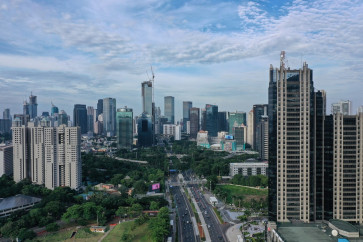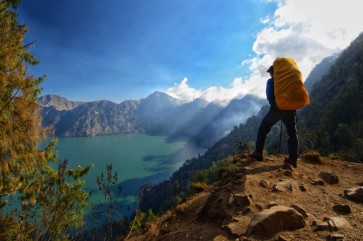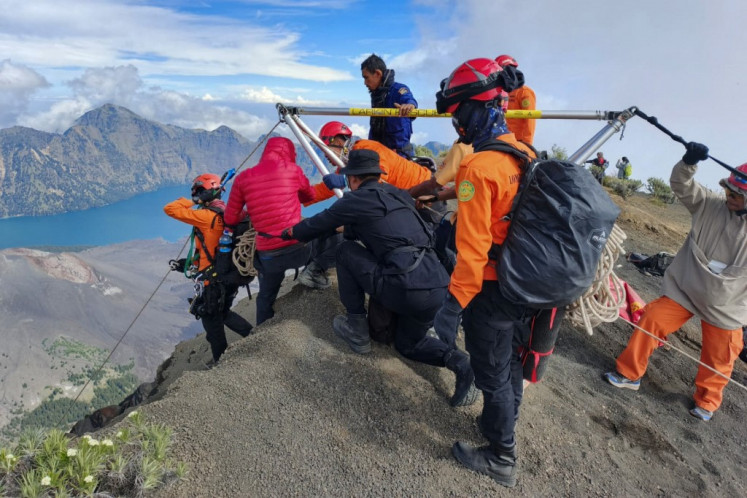Popular Reads
Top Results
Can't find what you're looking for?
View all search resultsPopular Reads
Top Results
Can't find what you're looking for?
View all search resultsErik Prasetya: Capturing the emotion of Jakarta
(JP/ Andreas D
Change text size
Gift Premium Articles
to Anyone
(JP/ Andreas D. Arditya)
While many ' if not, most ' of the people who live here love to hate it, Erik Prasetya sees a more colorful and joyful future for Jakarta.
'I am feeling highly optimistic about it. I sense the city is on the move and improving. This emotion of Jakarta is what I would like to convey with my ongoing work,' the renowned street photographer told a discussion at Salihara earlier this week ' much to the confusion of many in attendance.
'I know it may not sound like it ' the city's streets are as jammed as ever ' but you can see many of Jakartans have resorted to smiles and laugh at the traffic as they head out of their offices in the afternoon,' said Erik. 'It's terrible, terrible traffic ' but it is what it is. They've come to be happy with it.'
Erik has felt and captured a different sense of the city over the years.
He recorded and presented his testimony of bleak years in the capital in his 2011 book JAKARTA Estetika Banal ' a laboriously compiled collection of black-and-white pictures that he took between 1990 and 2010.
'Before the fall of Soeharto, it was very depressing in the city. It was a city without hope. There was a shroud over the New Order era. Everything required a permit from the authorities. You couldn't freely take photographs in public places.
'After Reform, there's an open feeling. It was unthinkable for people to spend the afternoon in Suropati Park, but now people practice music here,' he said referring to the park in Menteng, Central Jakarta.
Born in 1958 and raised in Padang, West Sumatra, before going to the Bandung Institute of Technology (ITB) in West Java in the late 1970s to study mining, Erik has adopted the capital as his home.
He describes his approach as estetika banal (banal aesthetics) ' something he said was born in Jakarta ' choosing not to capture drama or big moments, but instead on capturing daily events and moments from the photographer's life.
'Street photography, in essence, is capturing the emotion of a city,' said Erik, who recently was named one of the '30 Most Influential Photographers in Asia' by Invisible Photographer Asia.
Erik's photographs in the book blend street photography, documentary photography and traditional portraiture. His work has been called an influential reference point for young Indonesian photographers.
Photography has been part of Erik's life since he was a child. At the age of 10, Erik was taking pictures with a medium-format camera and processing the film himself.
He went to work in the oil industry after college before deciding that it was not his world, taking a sharp turn into journalism.
'I started as a reporter at a number of publications. But then I felt that writing was not my forte. Now taking pictures, that's my thing. I looked at National Geographic pictures and said to myself 'I can make pictures like these.' So I decided to become a photographer,' Erik said.
He became a freelance photographer in 1990, with his first photo essay published by Tempo magazine in the same year. Erik has since worked as a commercial and news photographer, although he is best known and regarded for his journalistic documentary work.
'I do projects for commercial clients too, because I have to fund my personal projects. I sometimes speak at seminars and teach to earn money. I recently published some postcard series, too,' he said. 'It's a good option for making money for photographers.'
For his current project, Erik strolls around Jakarta's streets three to four days a week. To support the physically demanding work, he jogs with his wife, the prominent writer Ayu Utami, four to five times a week.
A mountain climber during his college years, Erik said that he sorely misses hiking. 'I just don't have the time. It is also quite demanding on my aging body,' he said.
After toying with a black-and-white film camera for 20 years, Erik began taking color pictures with digital cameras over the past two years.
'I feel Jakarta is on the move, so I want to take colorful and playful pictures for ongoing projects. Besides, it's time to change; I don't want repetition,' he said, adding that the new project was slated for publication next year.
And why focus on Jakarta?
'First, because it is my home. Second, because it is a city that respects differences,' Erik said. 'You can only build a city for so long by denying plurality before ending up in a desert.'
Erik is part of the ongoing Jamboree Street Photography Indonesia at the Pannafoto Institute, in Kemang, South Jakarta. The event ends on June 25. For more information, visit jamborespi.com.










